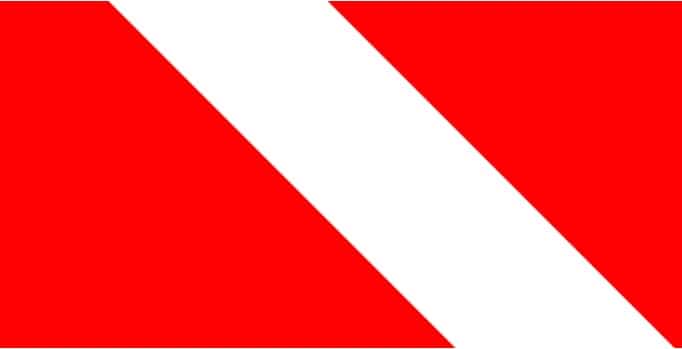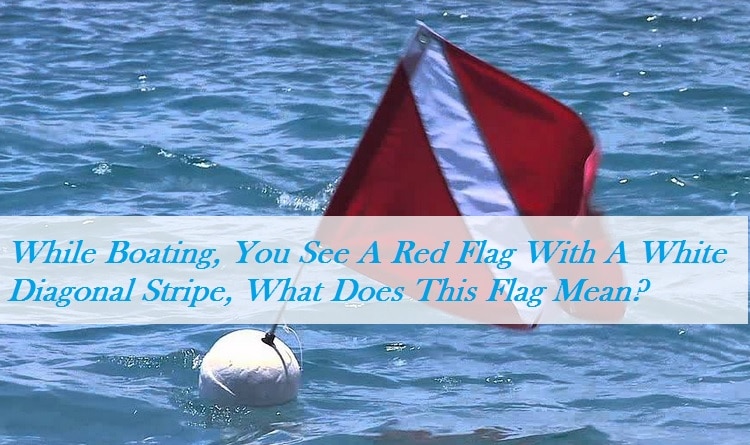What does a red flag with a white diagonal stripe mean while boating? When boating, it is pertinent to pay close attention to your surroundings. Otherwise, you may miss something important and it could lead to an untimely disaster.
At some point, you may encounter other boaters. If this happens, you need to focus on those individuals because they might send you signals. If they do, you’ll want to make sure that you notice those signals. It could make the difference between life and death. When you decide to go boating, you may notice a red flag with a white diagonal stripe.
What does this mean? How should you react to the signal? Within this guide, you’ll learn more about this flag and what it means.
The Red Flag
First, you’ll want to learn as much as you can about this red flag. What does it mean? Well, the flag was created by a Navy veteran by the name of Denzel James Dockery in 1956. It became popular after it was utilized by Ted Nixon.
The flag is often referred to as the diver down flag. It is one of the most important tools for scuba divers. If you’re going to be a part of a scuba group, you should carry one of these flags. Doing so will make a big difference in the long run.
In addition to this, you’ll find that you have to use these flags by law. If you’re diving in the United States, Europe, or Canada, you’ll likely need to display the flag when you’re submerged with other divers. Just remember that the divers may not be submerged directly beneath the flag. When scuba diving, it is important for divers to remain within 300 feet of the dive flag.
If you’re going to be diving in smaller waters, such as rivers and inlets, you should stay closer to the flag. A distance of 100 feet is recommended. When resurfacing, it is vital to come up within 150 feet of the flag.
Read Also: What do you do in areas of heavy boat traffic?
The Diver Down Flag
Ultimately, the diver-down flag is a flag that is used by scuba divers. The flag is primarily used on the water to indicate that divers are below the water’s surface. There are two types of diver down flags. In some parts of the world, divers use a white and blue flag to let boaters know that they’re diving.
In North America, divers use a red flag that has a white stripe. The white stripe goes from the upper left corner to the lower right corner. Furthermore, some of these flags feature reflective materials so you can easily spot them at night.
Be sure to learn more about common flags so you’ll know what to expect.
Boating Safely When Approaching Scuba Divers
As a boater, it is pertinent to use precautions when getting close to scuba divers. Failing to do so could lead to major issues in the long run. First and foremost, you should never estimate or guess the diver’s position. You never know when they’re located.
As a result, it is a good idea to stay at least 300 feet from the diver flag. Another thing to remember is that not all groups will use the diver down flag. If you approach a boat, you’ll want to stay 300 feet away from it. You never know if divers have jumped into the water without placing the flag or buoy.
When a diver reaches the surface, he or she may not be visible. You need to be cautious when boating. Don’t rush forward because you might hit someone.
Diver Guidelines
Whether you’re kayaking or diving, it is pertinent to practice safety. You never know when something is going to go wrong. By being prepared, you can minimize the risks involved. As a result, you’ll want to pay close attention to the guidelines set force by the biggest water sports associations. Doing so can help you remain safe while protecting others in the water as well. Below, you’ll discover tips to follow when diving or kayaking.
- Never enter the water when the boat’s engine is running. If you do, the risk of being injured is significantly high. Instead, you’ll want to let the engine die first. Let the boat come to a complete stop before climbing into the water.
- It is pertinent to prepare for potential problems. If you experience a problem, you’ll want to know how to deal with it. A good way to prepare is by developing emergency plans. When someone in your crew gets injured, you’ll want to know how to deal with the issue. How will you retrieve them? What do you need to do to get assistance? Create a plan so you’ll be ready for everything.
- When someone gets injured, take advantage of those diver-down flags. Boaters are trained to pay close attention to the flags in the water. As a result, you can use a diver down flags to alert incoming help to the location of the injured diver. In addition to this, you can use these flags to prevent the person from being injured by an incoming boat.
- Although drinking is fun, you should never do it on the water. You’ll want to wait until the fun on the water ends. Once you’ve done that, you can have a good time drinking. Never drink or use drinks when boating, kayaking, or diving. Doing so is simply too risky.
While Boating, You See A Red Flag With A White Diagonal Stripe, What Does This Flag Mean?
If you’re boating and you see a red flag with a diagonal stripe, you need to know what to do. It is pertinent to understand the meaning of the flag, so you can be ready for the situation. Below, you’ll find tips for dealing with the situation when you notice this flag in the water in front of you.
- It is best to keep your boat a safe distance from the flag. To be safe, you should stay at least 300 feet away from it. Never make assumptions because they could cause someone to get injured in the long run.
- Once you’ve become familiar with the area, you’ll likely know where divers tend to enter the water. When approaching these locations, slow down. Divers don’t always use the diver down flags. Instead, you need to slow down and use caution when getting close to common diving spots.
- At some point, someone may get too close to your boat. If this happens, you’ll want to communicate with that individual. Let them know that you’re approaching and they should stay clear of your boat. Keep your eyes on the water so you can look for divers and diver down flags.
- Don’t start your boat until you’ve surveyed the area. Make sure that nobody is close to the boat so you can start it without any issues.
- Don’t forget to bring your first aid kit. You never know when someone is going to get hurt, and you want to be ready. Bring the necessary first aid supplies so you can tend to an injury immediately.
- You’ll also want to scan the area for other flags. Familiarize yourself with the common flags used by boaters, kayaked, and divers so you can minimize the risks. Some of the most important include the Red Alpha Flag and Surface Marker Buoy.
Why The Flag Matters
Finally, you’ll want to learn more about the importance of the diver down flag. Why does it matter? Well, the flag lets you know that divers are beneath the water. If you approach the flag haphazardly, there is a risk that you’re going to run into someone and severely injure them. You don’t want this to happen. Divers are vulnerable when they’re in the water. To keep them safe, you’ll want to stay at least 300 feet away from the diver down flag.
Since some groups won’t place this flag, you’ll want to be cautious around popular diving spots as well.
Summary
Whether you’re boating, kayaking, or diving, you’re going to encounter a lot of unique situations. In some cases, you may notice a flag in the distance. You’ll want to learn more about common boating and diving flags so you’ll know how to handle the situation at hand.
Once you’ve learned more about these flags, you’ll know what they mean. Then, you’ll be able to handle the situation without getting hurt or injuring anyone. The diver down flag is one of the most important flags because divers are highly vulnerable when they’re in the water.
See Also: A Motorboat Is Crossing Paths With A PWC. What Action Should Be Taken?

Ever wondered how you can have a cruising boat without getting into financial problems? The answer is here. That is the reason why we set up this blog to share with you, safety tips, answers to questions that have to do with fishing and hunting. You are going to love it!
Hey! I am Armstrong!

